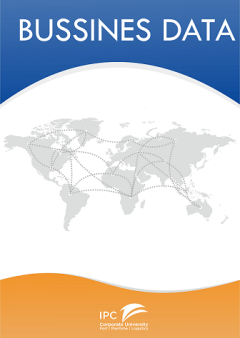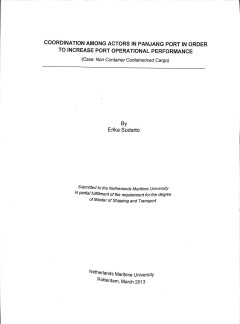Ditapis dengan

Industry brief - government expects usd9 .3bn foreign investment in maritime …
The Indones ian g overnment expects to receive USD9 .3bn in inves tments into the country's maritime s ector from four countries - Japan, Australia, South Korea and China - according to the Inves tment Coordinating Board (BKPM). 'Three inves tors from Aus tralia, South Korea and China will inves t in the development of dockyards and two inves tors from Japan and China will inves t in fis heries…
- Edisi
- -
- ISBN/ISSN
- -
- Deskripsi Fisik
- 1 p.
- Judul Seri
- -
- No. Panggil
- BD BMI i

A two-stage supply chain DEA model for measuring container-terminal efficiency
Despite the growing amount of research into container-port operations and efficiency, much of the literature on the subject treats container ports and terminals as black box systems without examining the structure of their transformation and production processes. Research on the network and multi-stage structure of container-terminal operating systems is scarce and its applications in the conte…
- Edisi
- Vol. 3, No. 1, 2011
- ISBN/ISSN
- -
- Deskripsi Fisik
- 1 p.
- Judul Seri
- Int. J. Shipping and Transport Logistics
- No. Panggil
- ATC LO BIC a c.1

Indonesia operational risk report Q3 2016 includes the BMI operational risk i…
Investors in Indonesia face a variety of challenges that hinder the business environment in the country. Chief among these risks are the restrictions on foreign direct investment (FDI), excessive red tape associated with trading and setting up a business, a poorly skilled labour market, a disjointed and highly variable logistics network and the threats to foreign workers and businesses from cri…
- Edisi
- -
- ISBN/ISSN
- 2055-8880
- Deskripsi Fisik
- 128 p.
- Judul Seri
- Part of BMI's Industry Report & Index
- No. Panggil
- BD BMI i

Indonesia operational risk report Q2 2016 : includes the BMI operational risk…
Investors in Indonesia face a variety of challenges that hinder the business environment in the country. Chief among these risks are the restrictions on foreign direct investment (FDI), excessive red tape associated with trading and setting up a business, a poorly skilled labour market, a disjointed and highly variable logistics network and the threats to foreign workers and businesses from cri…
- Edisi
- -
- ISBN/ISSN
- 2055-8880
- Deskripsi Fisik
- 134 p.
- Judul Seri
- Part of BMI's Industry Report & Index
- No. Panggil
- BD BMI i

Indonesia freight transport report Q1 2016 : Includes 5-year forecasts to 2019
In 2016 the air freight mode will see the most significant growth in Indonesia, as trade in Asia is set to rebalance after stalling in 2015 and key sectors such as the pharmaceutical market will see a boost in growth. In our medium-term forecast to 2019, BMI believes the rail and air freight modes will see higher growth than road freight transport, as a result of state and external investment i…
- Edisi
- Q1 2016
- ISBN/ISSN
- ISSN: 1752-5861
- Deskripsi Fisik
- 59 p.
- Judul Seri
- Part of BMI’s Industry Report & Forecasts Series
- No. Panggil
- BD BMI i

Indonesia operational risk report Q4 2016 : includes the BMI operational risk…
Investors in Indonesia face a variety of challenges that hinder the business environment in the country. Chief among these risks are the restrictions on foreign direct investment (FDI), excessive red tape associated with trading and setting up a business, a poorly skilled labour market, a disjointed and highly variable logistics network and the threats to foreign workers and businesses from cri…
- Edisi
- -
- ISBN/ISSN
- 2055-8880
- Deskripsi Fisik
- 126 p.
- Judul Seri
- Part of BMI's Industry Report & Index
- No. Panggil
- BD BMI i

Logistics and Transportation Security: A Strategic, Tactical, and Operational…
"Professor Burns has captured the essence of transportation security, one of today's most pressing concerns. As the rate of globalization and world trade increases, security and supply chain resilience are at the core of one’s global transportation network. This is a timely and well written contribution to the industry." —John A. Moseley, Senior Director of Trade Development, Port of Houst…
- Edisi
- -
- ISBN/ISSN
- 978-1-4822-5308-5
- Deskripsi Fisik
- xxxix, 359 p
- Judul Seri
- -
- No. Panggil
- TXT LO BUR l

Pricing policy and operational controls in container terminals
Following a general discussion on port pricing policies and structures the author explores the argument that price in itself provides an inadequate focus of needs and preferences of port users, especially users of container terminals, and suggests a system of input pricing related to the sale of terminal capability on a time basis.
- Edisi
- -
- ISBN/ISSN
- -
- Deskripsi Fisik
- 9 p.
- Judul Seri
- Maritime Policy & Management: The flagship journal of international shipping and port research
- No. Panggil
- ATC LO GIL

Supply chain innovation
- Edisi
- Vol. 49 Iss 4 pp. 152 - 155
- ISBN/ISSN
- -
- Deskripsi Fisik
- 6 p .
- Judul Seri
- Work Study
- No. Panggil
- ATC LO FRA s
- Edisi
- Vol. 49 Iss 4 pp. 152 - 155
- ISBN/ISSN
- -
- Deskripsi Fisik
- 6 p .
- Judul Seri
- Work Study
- No. Panggil
- ATC LO FRA s

Company brief - IPC draws up port development plan
State-owned Indonesia Port Company (IPC) has drawn up an ambitious port development plan as part of the g overnment's Sea Toll programme, which is aimed at s ig nificantly reducing the country's log is tics cos ts . Under the plan, the company intends to develop 35 new ports in a period of four years to encourag e economic development outs ide Java Is land - mainly in the outlying is lands of t…
- Edisi
- -
- ISBN/ISSN
- -
- Deskripsi Fisik
- 1 p.
- Judul Seri
- -
- No. Panggil
- BD BMI c

Indonesia Consumer electronics report : Includes 5-year forecasts to 2021
We have downgraded Indonesia's economic growth forecast to 5.1% in 2017 as the mining sector is showing little sign of picking up despite the easing of the mineral export ban, while the manufacturing and retail and wholesale sectors appear to be on a slight downturn. Rising political risks in the run-up to the 2019 elections are also likely to weigh on growth going into 2018, although we expect…
- Edisi
- -
- ISBN/ISSN
- -
- Deskripsi Fisik
- 42 p.
- Judul Seri
- -
- No. Panggil
- BD BMI i

Indonesia Country Risk Report : Includes 10-year forecasts to 2026
Indonesia's poor net international investment position, along with a current account deficit, makes it vulnerable to periods of acute risk aversion in the global economy. In an environment of rising global interest rates, this is an increasing risk.
- Edisi
- Q3 2017
- ISBN/ISSN
- -
- Deskripsi Fisik
- 46 p.
- Judul Seri
- -
- No. Panggil
- BD BMI i

Retail operational strategies in complex supply chains
The correct choice, implementation and evolution of an operations strategy can provide considerable competitive advantage. However, how many organizations in the Fast Moving Consumer Goods (FMCG) industries really understand the components of such strategies and their power when properly deployed? Supply chain management, lean thinking, agile operations, quick response, virtual organization, ti…
- Edisi
- Vol. 12 Issue: 1, pp.97-111
- ISBN/ISSN
- -
- Deskripsi Fisik
- 17 p.
- Judul Seri
- The International Journal of Logistics Management
- No. Panggil
- ATC LO LOW r

Great divides: internal alignment between logistics and peer functions
The purpose of this paper is to review and synthesize the extant logistics literature on internal functional alignment to: create an inventory of prior research on this issue; identify areas that require additional examination, and; highlight opportunities and approaches for further research.
- Edisi
- Vol. 19 No. 2, 2008 pp. 110-129
- ISBN/ISSN
- -
- Deskripsi Fisik
- 23 p.
- Judul Seri
- The International Journal of Logistics Management
- No. Panggil
- ATC LO ELL g

Strategic intent, measurement capability, and operational success: making the…
From strategic intent to core competences to supply-chain relationships, companies have been forced by dynamic and intense competitive pressures to re-evaluate almost every aspect of their approach to conducting business. These re-evaluations have in turn led to the implementation of dramatic strategic initiatives that range from benchmarking to just-in-time to re-engineering to total quality m…
- Edisi
- Vol. 27 No. 7, 1997
- ISBN/ISSN
- -
- Deskripsi Fisik
- 14 p.
- Judul Seri
- International Journal of Physical Distribution & Logistics Management
- No. Panggil
- ATC LO BIX s

Coordination Among Actors In Panjang Port In Order To Increase Port Operation…
- Edisi
- -
- ISBN/ISSN
- -
- Deskripsi Fisik
- x, 70 p., : illus : table
- Judul Seri
- -
- No. Panggil
- PO SUD c
- Edisi
- -
- ISBN/ISSN
- -
- Deskripsi Fisik
- x, 70 p., : illus : table
- Judul Seri
- -
- No. Panggil
- PO SUD c
 Karya Umum
Karya Umum  Filsafat
Filsafat  Agama
Agama  Ilmu-ilmu Sosial
Ilmu-ilmu Sosial  Bahasa
Bahasa  Ilmu-ilmu Murni
Ilmu-ilmu Murni  Ilmu-ilmu Terapan
Ilmu-ilmu Terapan  Kesenian, Hiburan, dan Olahraga
Kesenian, Hiburan, dan Olahraga  Kesusastraan
Kesusastraan  Geografi dan Sejarah
Geografi dan Sejarah